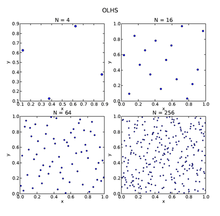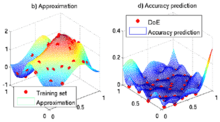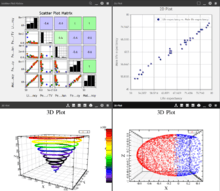pSeven
 | |
| Developer(s) | DATADVANCE LLC |
|---|---|
| Stable release |
6.9 SP 1
/ November 3, 2016 |
| Development status | Active |
| Operating system | Cross-platform (Windows, Linux) |
| Available in | English |
| License | Proprietary |
| Website |
www |
pSeven is a design space exploration software platform developed by DATADVANCE LLC, extending design, simulation and analysis capabilities and assisting in smarter and faster design decisions. It provides a seamless integration with third party CAD and CAE software tools, powerful multi-objective and robust optimization algorithms, data analysis and uncertainty management tools.[1] pSeven comes under the notion of PIDO (Process Integration and Design Optimization) software. Design space exploration functionality is based on the mathematical algorithms of pSeven Core (formerly known as MACROS) software library,[2] also developed by DATADVANCE.
Design Space Exploration with pSeven allows creating predictive modes, integrating CAD/CAE tools, identify models, analyze data and models, explore design alternatives and make smart decisions. SmartSelection technology implemented in pSeven Core automatically selects the most efficient method for a given data or optimization problem that makes advance math easy to use to a wide range of experts.
History
The foundation for the pSeven Core library as pSeven's background was laid in 2003, when the researchers from the Institute for Information Transmission Problems of the Russian Academy of Sciences [3] started collaborating with Airbus Group to perform R&D in the domains of simulation and data analysis. The first version of pSeven Core library was created in association with EADS Innovation Works in 2009.[4] Since 2012,[5] pSeven software platform for simulation automation, data analysis and optimization is developed and marketed by DATADVANCE, incorporating pSeven Core.
Functionality
pSeven's functionality includes three major blocks: Process integration, Design Space Exploration, Vizualisation and Post-processing.
Process integration

Process integration capabilities are used to capture the design process by automating single simulation, trade-off studies and design space exploration. For that, pSeven provides tools to build and automatically run the workflow, to configure and share workflows with other design team members, to distribute computation over different computing resources, including HPC. Main process integration tools of pSeven:
- Graphical user interface and command-line interface for advanced users
- Comprehensive library of workflow building blocks
- CAD/CAE integration adapters (SolidWorks, CATIA, NX, PTC Creo, KOMPAS-3D, ANSYS Workbench), CAE solvers and other engineering tools (ANSYS Mechanical, ANSYS CFD, FloEFD, CST Microwave Studio, ADAMS, Simulink, MATLAB, Scilab, Abaqus, Unified FEA, Nastran, LS-DYNA, STAR-CCM+, OpenFOAM, etc.)
- Workflow as a Ready Tool mechanism
- High Performance Computing (HPC) capabilities (supported batch systems: SLURM, TORQUE, LSF)
Design space exploration
Design Space Exploration toolset in pSeven offers a variety of methods for:
- Parametric Studies
- Design of Experiments
- Sensitivity and Dependency Analysis
- Surrogate modeling
- Single and Multi-Objective Optimization
- Uncertainty Management
- Robust and Reliability Based Design Optimization
Design of experiments

Design of Experiments includes the following techniques: Space Filling
- Batch techniques (Random, Full-Factorial, Latin hypercube sampling, Optimal LHS)
- Sequential techniques (Random, Halton, Sobol, Faure sequences)
Optimal Designs for RSM
- Composite, D-optimal, IV-optimal, Box Behnken
Adaptive DoE with Uniform, Maximum Variance and Integrated Mean Squared Errors Gain - Maximum Variance criteria.
Design of Experiments allows controlling the process of surrogate modeling via adaptive sampling plan, which benefits quality of approximation. As a result, it ensures time and resource saving on experiments and smarter decision-making based on the detailed knowledge of the design space.
Sensitivity and dependency analysis
Sensitivity and Dependency Analysis is used to filter non-informative design parameters in the study, ranking the informative ones with respect to their influence on the given response function and selecting parameters that provide the best approximation. It is applied to better understand the variables affecting the design process. It comprises the following steps:
- Feature selection
- Feature extraction
- Sensitivity analysis
The techniques below are included in pSeven to perform Sensitivity and Dependency Analysis: Popular correlation coefficients:
Screening indices:
- Can be computed even with very small budget
- In addition to providing ranking indices allow to check linearity and monotonicity of objective with respect to each input
Sobol indices:
- Total indices – measure total effects (tell which portion of objective would be lost if one would fix considered input)
- Main indices – measure first order effects (tell which portion of objective is explained by considered input if all other inputs are fixed).
- Interaction indices – measure higher order effects (difference between Total and Main).
- Robustness of objective towards noise in each input
- Statistical significance check
Surrogate modeling
Surrogate modeling (or Approximation) capabilities in pSeven incorporate several proprietary surrogate modeling techniques, including methods for ordered and structured data, allowing to understand behavior of user's system with minimal costs, replace expensive computations by surrogate models (metamodels) and make smarter decisions based on detailed knowledge of the design space [6]

- Classic methods (Splines[7] Linear Regression, Kriging, etc.)
- Proprietary methods (Higher Dimensional Approximation, SGP - Sparse Gaussian Processes, Tensor Approximation and incomplete Tensor Approximation, Tensor Gaussian Processes etc.)
These methods provide users with the following features:
- Accuracy assessment of constructed models
- Full control of the model construction time
- Smoothing [8]
- Surrogate model export (C, MATLAB, Octave)
- Construction of variable fidelity models
"Smart Selection" automatically picks the best suitable technique based on a few user-defined problem settings. Surrogate modeling allows user getting value from experimental data and perform faster and cheaper system behavior analysis.
Data fusion
Data fusion in pSeven's functionality is used to better handle and increase efficiency of surrogate modeling. It allows constructing surrogate models using data of different levels of fidelity, handle samples of varied sizes and perform accuracy evaluation. It allows managing a surrogate model construction time, estimate uncertainty for predictions obtained with a Data Fusion-based surrogate model and estimate the quality of models constructed. Data Fusion technology works in two modes:
- sample-based (tool takes high fidelity sample and a low fidelity sample as inputs. These samples consist of points and corresponding values of a considered function)
- blackbox-based (tool takes high fidelity sample and a low fidelity blackbox as inputs. In this mode low fidelity function blackbox provides low fidelity function values at any feasible point from a specified design space)
Data Fusion techniques available in pSeven:
- HFA (High Fidelity Approximation) – uses only high fidelity data,
- DA (Difference Approximation) — approximates difference between low and high fidelity data
- VFGP (Variable Fidelty Gaussian Processes) — builds models using Gaussian processes regression ideas
- SVFGP (Sparse Variable Fidelity Gaussian Processes) is designed to handle large samples with Gaussian processes regression-based technique.
Optimization
Optimization algorithms implemented in pSeven allow solving single and multiobjective constrained optimization problems as well as robust and reliability based design optimization problems. Users can solve both engineering optimization problems with cheap to evaluate semi-analytical models and the problems with expensive (in terms of CPU time) objective functions and constraints.[9][10] Smart Selection technique automatically and adaptively selects the most suitable optimization algorithm for a given optimization problem from a pool of optimization methods and algorithms in pSeven. Main classes of optimization problems which are supported:
| Type of problem | N, box bounds | K, objective functions | M, generic constraints |
|---|---|---|---|
| Linear problems (including mixed-integer) | O(106) | 1[linear] | O(106)[linear] |
| Quadratic indefinite problems | O(104) | 1[quadratic] | O(104)[linear] |
| Unconstrained single-objective problems | O(104) | 1 | 0 |
| Constrained single-objective problems | O(104) | 1 | O(104) |
| Constraint satisfaction problems | O(104) | 0 | O(104) |
| Multi-objective constrained optimization problems | O(104) | O(10) | O(104) |
| Computationally expensive problems | O(10) | O(1) | O(10) |
Optimization methods available in pSeven:
- Noisy data handling techniques
- Mathematical programming: Mixed-Integer Linear Programming (MILP)
- Mathematical programming: Quadratic programming (QP)
- Mathematical programming: Unconstrained Nonlinear programming (UNLP)
- Mathematical programming: Constrained Non-Linear programming (NLP)
- Constraint Satisfaction Problems (CSP)
- Multi-Objective Optimization [11]
- Surrogate-Based Optimization (SBO):[12][13][14] constrained single-objective problems
- Surrogate-Based Optimization (SBO): constrained multi-objective problems
- Global Search Methods (excluding SBO)
- Robust Optimization
Uncertainty management
Uncertainty Management capabilities in pSeven [15] are based on OpenTURNS library. They are used to improve the quality of products designed, manage potential risks at the design, manufacturing and operating stages and to guarantee product reliability. A range of uncertainty management algorithms allows to perform: Quantification of uncertainty sources (based on experimental data or expert knowledge)
- Probabilistic model (non-parametric, e.g. Kernel Smoothing; parametric, e.g. Normal, Beta)
- Auto-selection of distribution type for parameters sample
- Goodness-of-fit tests for sample-based probability models (e.g. Kolmogorov-Smirnov test)
- Dependencies of input parameters (e.g. Spearman correlation coefficient)
Uncertainty propagation using Monte-Carlo simulation
- Central dispersion, output distribution analysis (Monte Carlo)
- Failure probability (Reliability analysis): approximation (FORM), simulation (Monte Carlo, LHS, Directional sampling)
Reliability analysis
- Monte-Carlo approach
- Surrogate model approach
Reliability-based design optimization

Visualization and post-processing
Visualization and post-processing tools in pSeven are used to analyze the results of design space exploration procedures and include:
- Plot configuration dialogs
- Structured Parallel coordinates
- Scatter plot Matrices
- 2D- and 3D-plots
- Table view and drag-and drop options
Application areas and customers
pSeven's application areas are different industries such as aerospace,[16][17] automotive, energy, electronics and electrical appliances, banking, insurance, biotechnology and others. Application examples:
- Multidisciplinary and multi-objective optimization of an aircraft family [18]
- Sizing of composite structures in order to reduce their mass subject to various mechanical and manufacturing constraints
- Construction of quick and accurate behavioral models (surrogate models) in order to enable efficient and secure exchange of models across Extended Enterprise
- Optimization of the gas path of the steam turbine in order to improve overall turbine efficiency
- Optimization of layered composite armor in order to reduce its weight [19]
Modules and Packs
Three pSeven configurations are available, each of them with different functionality modules:
- pSeven Basic (Workflow construction, execution and post-processing capabilities)
- pSeven MDO (Workflow construction, execution and post-processing capabilities - pSeven Core for data analysis and optimization)
- pSeven Ultimate (Workflow construction, execution and post-processing capabilities, pSeven Core tools for data analysis and optimization, CAD/CAE software integration tools and HPC integration toolset, Uncertainty management capabilities).
- pSeven Core algorithmic library can also be purchased as a standalone product, which includes Generic Tools for Optimization, Approximation, Data Fusion, Dimension Reduction, Design of Experiments and Sensitivity and Dependency Analysis.
References
- ↑ "Software development company DATADVANCE - Trade Delegation of the Russian Federation in the United Kingdom". rustrade.org.uk. Retrieved 2016-08-03.
- ↑ "pSeven Core - DATADVANCE". www.datadvance.net. Retrieved 2016-08-03.
- ↑ Institute of Information Transmission Problems
- ↑ Interview of Sergey Morozov, CTO of DATADVANCE, "The Moscow Times", issue № 3 (45) 2014
- ↑ OraResearch, Design Space Exploration Industry Timeline
- ↑ Burnaev E., Prikhodko P., Struzik A., "Surrogate models for helicopter loads problems", Proceedings of 5th European Conference for Aerospace Science"
- ↑ Golubev Y., Krymova E., "Splines and Stationary Gaussian Processes", Proceedings of the conference "Information Technologies and Systems", 2012
- ↑ Bernstein A., Belyaev M., Burnaev E., Yanovich, Yu., Smoothing of Surrogate Models, Proceedings of the conf. "Information Technologies and Systems", 2011. P. 423-432.
- ↑ F. Gubarev, V. Kunin, A. Pospelov, "Lay-up Optimization of Laminated Composites: Mixed Approach with Exact Feasibility Bounds on Lamination Parameters"
- ↑ Dmitry Khominich, Fedor Gubarev, Alexis Pospelov, "Shape Optimization of Rotating Disks", 20th Conference of the International Federation of Operational Research Societies, 2014
- ↑ Alexis Pospelov, Fedor Gubarev, "Nonlinear Multi-Objective Constrained Optimization", 20th Conference of the International Federation of Operational Research Societies, 2014
- ↑ Grihon S., Alestra S., Burnaev E., Prikhodko P., "Surrogate Modeling of Buckling Analysis in Support of Composite Structure Optimization", 1st International Conference on Composites Dynamics
- ↑ Alexis I. Pospelov, Fedor V. Gubarev, Alexey M. Nazarenko, "Adaptive Surrogate-Based Multi-Criteria Optimization", 11th World Congress on Computational Mechanics (WCCM XI)
- ↑ F.V. Gubarev, A.I. Pospelov, "Towards Large-Scale Surrogate-Based Optimization", 4th International Conference of Engineering Optimization, 2014
- ↑ DATADVANCE Ships pSeven v4.0 for Data Analysis, Optimization, TenLinks CAD, CAM and CAE news
- ↑ Airbus achieves multi-objective optimization of its aircraft families with DATADVANCE's "Macros" software
- ↑ Skolkovo resident DATADVANCE tows Airbus through structural testing on new A350
- ↑ Alestra S., Brand C., Druot T., Morozov S., "Multi-objective Optimization of Aircrafts [sic] Family at Conceptual Design Stage", IPDO 2013 : 4th Inverse problems, design and optimization symposium, 2013 June 26–28, Albi, ed. by O. Fudym, J.-L. Battaglia, G.S. Dulikravich et al., Albi ; Ecole des Mines d'Albi-Carmaux, 2013 (ISBN 979-10-91526-01-2)
- ↑ A. Bragov, F. Antonov, S. Morozov, D. Khominich, "Numerical optimization of the multi-layered composite armor", Light-Weight Armour Group (LWAG) conference-2014